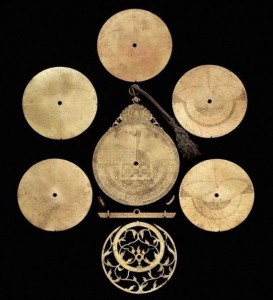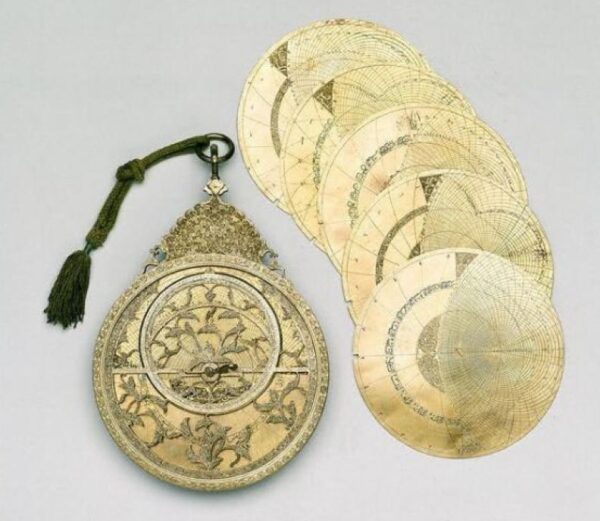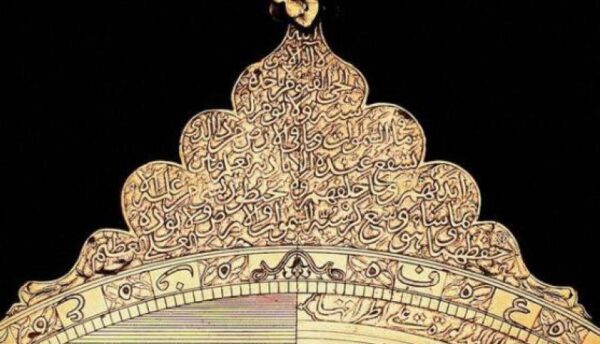One particular achievement of the Golden Age of Islam is the Astrolabe, an astronomical instrument from the 12th century; let’s learn more about it!
Using the Astrolobe from Muslim Heritage
by Emily Winterburn*
Al Sufi, one of the most famous astronomers of the Islamic world, was writing in Isfahan (in modern day Iran) in the 10th century. In his writings, he outlined over 1000 uses of an astrolabe. Accounts of the astrolabe as a scientific instrument range from the very earliest given by the Greek astronomer Hipparchus in around 150 BCE, through writings from the Islamic world, to modern day descriptions by historians and curators. All emphasize that the astrolabe is an extremely versatile instrument.
The fundamental operation of astrolabes has varied little in their long history. All use the relationship between the apparent movement of the stars, as seen from a particular latitude on Earth, and time – allowing them to be used to find the time from the stars or Sun, and the position of the stars and Sun at a particular time (a feature particularly useful when casting horoscopes). All similarly have the flexibility to be used as both an observational instrument and as an aid to mathematical calculation.
Origin and Spread
The astrolabe is thought to have originated in Ancient Greece. Though no examples have survived, Hipparchus, writing in around 150 BCE, is credited with discovering ‘stereographic projection’, the mathematical means of representing the 3D sky onto a 2D plate that is the basis of how the astrolabe works. While the origin of the astrolabe may have been Greek, it is generally agreed that the design was then perfected in the Islamic world – indeed the name Astrolabe comes from the Arabic version of the Greek term ‘Star holder’. The earliest surviving physical example of an astrolabe belongs to a private collection on permanent loan to the Kuwait National Museum and has been travelling the world in a touring exhibition called ‘Islamic Art and Patronage, Treasures from Kuwait’ since the Gulf War (1991). The astrolabe in question was made in Iraq and signed and dated Nastalus, 315 H (927-928 CE).

An astrolabe is made up of 4 main pieces: Structure
– the mater or base plate,
– the rete or top web-like plate which shows the fixed stars, the ecliptic (the zodiac constellations and part of the sky across which the Sun travels) and certain naked eye stars,
– the plates, each of which is made for a different latitude. Each plate has engraved on it a grid marking the zenith (point directly over head), the horizon and all the altitudes in between;
– the alidade or rule with sights used for making observations and reading off scales.
The rete and plates are designed to fit into the mater.



Observations
To make an observation with an astrolabe, you need to hold it with the ring at the top to ensure it hangs down straight.
If observing the Sun, you then hold it out and line up the rule so that the Sun’s beam travels through both sights onto a point on the ground. This is because you must not look directly at the Sun. The degree scale around the edge of the back of the mater will give you the altitude or angular height of the Sun above the horizon.
If observing a star you hold it up and look though both sights up at the star and again read off the angle where the rule crosses the degree scale.
If observing the height of a building you need first to measure your position from the base of the building, then look through both sights at the top of the building, then read off the shadow square the ratio of vertical to horizontal distance given by where the rule crosses on the shadow square.


Calculations: telling the time from the Sun or stars
One of the most common calculations that can be made with an astrolabe is to find the time using the Sun or stars.
– This is done by first selecting the plate appropriate to your latitude. Each plate is engraved with concentric circles marking out degrees of altitude from 0 at the horizon to 90 at the zenith (or the point directly above the observer).
– Next, observe the star to find its altitude (see above).
– You then find that star on the rete.
– Rotate the rete until the pointer for that star lines up with its altitude on the plate.
– Finally, attach the rule to the front of the astrolabe and then rotate the rule until it lines up with the star at its correct altitude.
– The time can then be read from the scale around the rim of the mater.
The process is very much the same when finding the time from the altitude of the Sun, except that you need to add in an extra stage.
Using the calendar scale on the back, find the position of the Sun in the ecliptic (i.e. the corresponding part of the sign of the zodiac for that date). This part of the ecliptic on the rete then acts in place of a star pointer, and as before is lined up with the correct altitude on the plate beneath.
Calculations: finding the time of sunrise or sunset
To make predictions about when the Sun will appear in a particular part of the sky as seen from a particular latitude on a particular date, the process needed is roughly the reverse of that described above.
– First you need to find the position of the Sun in the ecliptic for that date using the calendar scales on the back of the astrolabe.
– Next you need to rotate the rete to line up that part of the ecliptic on the rete with the horizon on the plate for your latitude. For sunrise, use the horizon line to the left (east) of the centre, for sunset use the horizon line to the right (west).
– Then as before, rotate the rule until it lines up with the ecliptic at the horizon and read off the time on the hour scale around the rim of the mater.
Calculations: casting horoscopes
To cast a horoscope, it is necessary to know the position of the stars visible in the sky at the time of birth.
Using the same principles as above, this can be done by:
– finding the position of the Sun in the ecliptic for the date of the birth in question and select the correct plate for the latitude of the birth.
– Then, rotate the rule until it lines up with the time of birth.
– Next, rotate the rete until the part of the ecliptic relating to the correct date rule.
This setup of the astrolabe then shows all the stars visible in the sky. All the stars shown on the rete above the horizon were visible at the time of birth, all those on the horizon were just rising or just setting, and all those below it were not visible at that time.
In addition to this feature, many astrolabes also have tables engraved on the back displaying other astrological information that might be useful in the casting of horoscopes. These include tables of triplicities (showing which zodiac signs are Fire, Earth, Water or Air), the zodiac subdivided into limits (5 unequal divisions of each sign), decans (3 equal divisions of each sign) and faces (2 polarities – positive and negative – for the rulers for each decan) and information about the planets ruling each sign.
There is also sometimes information on the lunar mansions, a feature of astrology thought to have originated in India that subdivides the zodiac into 28 (instead of 12) sections, each referring to the position of the Moon in the zodiac for a particular day. Similarly, some astrolabes have the 12 astrological housesmarked out on the latitude plates since it is through these that the stars move over the course of 24 hours.
Calculations: religious applications
Additional features unique to Islamic astrolabes (and not featured in all of those) are those tables designed to aid the carrying out of the 5 pillars of Islam. Of the 5 pillars, the two most dependent on astronomical observation and calculation are finding the qibla or direction of Mecca and predicting prayer times, and for these many Islamic astrolabes carry special tables.
Qibla
One quarter of the back of some astrolabes have a grid made up of concentric quarter circles (or arcs of sine) each representing the date or zodiac sign in which the Sun would be found at that date. Cutting through these are lines running from the centere of the circle to the edge; these represent particular cities. To use this to find the direction of Mecca (the qibla) from one of these cities, move the rule to the point at which the city line crosses the date line for today’s date. This gives the altitude (on the outer degree scale) of the Sun at the point in that day when it is in the direction of Mecca. This method uses the fact that the Sun changes altitude and azimuth (travelling from East to West) as it crosses the sky.

Gazetteer
Often as an alternative to the qibla, many astrolabes contain a gazetteer or table listing place names, their latitude and longitude and the direction from that point to Mecca roughly (for example NW) and more exactly. Gazetteers are often found today in booklets alongside a compass allowing prayer mats to be properly aligned.
 Prayer lines
Prayer lines
Some astrolabes also have prayer lines engraved on the plates, since these are related to the position of the Sun in the sky and are therefore latitude dependent.

Inscriptions
One final indication we find on many Islamic astrolabes, which gives them a religious dimension as opposed to simply being Arabic but non-religious, is the inscriptions. On many Islamic astrolabes we find passages from the Quran, dedications, religious verses and of course the date given according to the Hijra calendar.

A popular passage from the Koran (Ayat al-Kursi – 2:255), found on a number of astrolabes is this found on the throne of this astrolabe:
God! There is no god but He, the Living, the Self-subsisting, Eternal. No slumber can seize Him, nor sleep. His are all things in the heavens and on Earth. Who is there can intercede in His presence except as He permitteth? He knoweth what (appeareth to His creatures as) before or after or behind them. Nor shall they compass aught of His knowledge except as Hewilleth. His Throne doth extend over the heavens and the Earth, and He feeleth no fatigue in guarding and preserving them. For He is the Most High, the Supreme (in glory).

Appearance, region and time
Astrolabes have never been solely scientific instruments; they have always been objects of beauty as much as of function. As such, their appearance can often tell us not only how they were used but also where, when and for whom they were made.

This one, on the other hand, reflects the prosperous and cultured time and place in which it was made. Made during the reign of the Safavid dynasty in Iran in the 18th century, it is like the art and architecture of that time and place, beautifully made with as much attention paid to its aesthetic perfection as to its scientific accuracy.


Astrolabes today
The astrolabe was introduced into the Christian West around the 13th century CE via Islamic Spain. Europeans adopted the astrolabe along with the various astronomical texts – some translations of Greek originals, some purely Arabic – and it had become widespread within learned circles by the 14th century.

The astrolabe fell out of fashion as a scientific tool in the West in the 17th century, as a whole range of other instruments catering to specific needs – the telescope for observation being the most significant – that had previously been carried out by the astrolabe were developed. As a collectors’ item, the astrolabe was rediscovered in the West in the mid-19th century, and today examples can be found of astrolabes from around the world in museums. Included in those collections are a number of fakes made in the 19th century, made in response to their new-found popularity among non-scientific collectors.
 In the East, however, the compactness of the astrolabe allowing so many functions to be performed by just one handy and portable instrument continued to be valued until well into the 19th century. Today, in many parts of the Islamic world, the astrolabe is still seen as a symbol of scientific and cultural excellence and its image features in company logos, formal gardens and even shopping centers.
In the East, however, the compactness of the astrolabe allowing so many functions to be performed by just one handy and portable instrument continued to be valued until well into the 19th century. Today, in many parts of the Islamic world, the astrolabe is still seen as a symbol of scientific and cultural excellence and its image features in company logos, formal gardens and even shopping centers.


